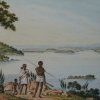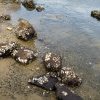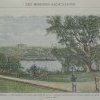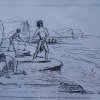1820s
Biddy Lewis accepts a grant of land at Marramarra Creek. Her husband John Lewis Ferdinand, also known as John Lewis, is a Prussian soldier in the German army and has fought in the Napoleonic wars. John meets Biddy while working as an assigned convict on Bungaree’s farm. He and Biddy have 10 children, seven survive. The family lives by fishing and oyster gathering as well as boat building and selling fruit from their orchard, while Biddy acts as midwife for the whole district. A story is told that Lewis, sailing his boat, would often say to Biddy “Sit in the bow of the boat, Biddy, so I can look at your beautiful face”. There are known descendants of their children Elizabeth, Mary Ann, James, Thomas and Catherine. The family flourishes and lives by burning lime to sell for mortar, boat building, growing fruit and fishing. Biddy is a fisherwoman and farmer.
One child, Catherine, marries Joseph Benns, a Belgian. They settle on Scotland Island, Pittwater. Catherine becomes known as the ‘Queen of Scotland Island’, and also becomes a famous midwife.
Birth of Esther Aitken, a descendant of Kitty and a Guringai woman, whose name appears on the blanket distribution lists for Brisbane Waters.
1820-30s
Northern Sydney clans are in decline due to dispossession of their land and removal of their access to the food traditionally gathered by the sea. The Koori birth rate decreases. Paintings of the period show Koori people with grog bottles and fighting, existing on charity in the streets of Sydney. Alcohol has tragic consequences in illness and mortality
1820
A Russian expedition lead by Captain Bellinghausen, visits Bungaree’s clan at Kirribilli. Pavel Mikhailov (the Russian expeditioner and artist) draws Bungaree and many of his clan, including Diana Boongaree daughter of Matora. Other family members who are named and drawn by Mikhailov include Matora herself (first wife of Bungaree).
The artist draws or records other names of the people in Bungaree’s clan. Boin (Bowen) is Bungaree’s son. His mother is Toura. Bowen’s wife is Maria or Mary, her father is Jonza and her mother is Nan or Naney. Bowen’s daughters are Theda, Theela Bowen and his son Mark.
Macquarie gives the Russians freedom to investigate the local Koori conditions, social life and dealings with colonial officials. Those whom they see along the north side of the harbour are “extremely lean and quite black in colour … They subsist on a mixed diet of shell fish and fish, forest products, and exchange their fish for British goods. They hunt and the women fish or gather bush food, then they withdraw into the bush at night. They sleep by fires and never lack a fire, embers even burn in the noon day heat”. Mikhailov writes of Bungaree’s family “Sometimes they ornament their head with bird’s bones or fish bones, or the tail of a dog or kangaroo teeth; and sometimes they plait their hair, smearing it with gummy sap of a plant so that it resembles rope ends. They stain the face and body with red earth … When a youth reaches man’s estate [ie manhood], two of his front teeth are knocked out. As for the girls, in early youth they have two joints of the little finger of the left hand cut off”. Since the men in Bungaree’s group were often absent from Kirribili, Mikhailov concentrated in his painting on the women and children. Volendens,Gulanba Duby, Gouroungan, Ga-ouen-ren, Matora. Male figures drawn are Boongaree, Bourinoan, Movat, Salmanda, Boin (Bowen) and Toubi (Toby). (Barratt 1991)
1821
Bungaree is living near Newcastle and his clan put on a “Kauraberie” for Macquarie during his farewell tour of the colony. The Governor persuades Bungaree and his family group to move back to Georges Head. The day before he embarks on ship for England, Macquarie visits Bungaree to say farewell and to present him with Macquarie’s old uniform and a new boat to use for fishing and greeting arriving ships in the harbour. Bungaree returns to Sydney and becomes a familiar figure and a lively interpreter for his people. He is a famous mimic of the colonial authorities.
1822
1823
James Webb, at Booker Bay on the Central Coast, has a working knowledge of Aboriginal languages. He helps to negotiate with Koories at the Rip and at Booker Bay to clear the forest. Koori men are good at working with saw and axes, women help with feeding animals and working around the farm. (Swancott 1955)
Aboriginal people roaming the forest sometimes pilfer settler vegetables.
1824
1825
1826
Many incidents of Aboriginal people defending their land and attacking the English farms north of Broken Bay. The activities of bushrangers, escaped convicts, cedar getters, illicit grog suppliers and smugglers create a lawless frontier in the northern regions. The first Magistrate Willoughby Bean is appointed in a vain attempt to restore order.
Surviving Koories are estimated to be only 65 on the Central Coast. Diseases such as smallpox, syphilis and influenza have killed many and others have been killed by settlers.
Attacks on settlers continue, and probably are supplemented from warriors coming from further north. A punitive expedition is mounted by the British against Koories near Wyong. Twenty Koories are captured and later eight are imprisoned on Cockatoo Island in Sydney Harbour. Governor Bourke requests that a school teacher “should be prepared to teach elements of Christianity to the Aborigines held there”. (Bourke to Secretary of State, Historical Records of New South Wales, 1 May 1835)
1828
Magistrate Willoughby Bean reports incidents between Aborigines and settlers.The district had within the last 5 to 6 months been greatly disturbed by the inroads of several tribes of Aborigines, I believe from the Hunter River, the Wollombi and the Sugar Loaf. These tribes have frequently assembled in great numbers (upwards of 200) and they have destroyed the settlers’ crops … Mr Henderson, the district Constable … deemed it prudent to arm 15 men from home and to go in pursuit of them. He overtook and drove them before him along the coast to the northward till night came on, when they doubled upon him and returned. He took two of them home and released them some days. They confessed that it was their intention not only to rob the settlers but likewise to capture and burn the gentleman of the name Cape who had fired upon them … during the stealing of his corn. (Historical Records of New South Wales)
The first Census of the native population is taken in the Brisbane Water by Magistrate Bean. He reports five family groups of natives (he refers to them as tribes). These family groups are centred at Broken Bay (15 people), Erina (10), Narara (10), Tuggerah Beach (15) and Wyong (15). The groups are: The Mial or Broken Bay; Narara; Erina; Tuggerah Beach; Wyong. He estimates a total of 65 persons. He notes evidence of recent Koori settlement at Kincumber, Patonga, Somersby, Ourimbah, Wyong River, Jilliby Creek valleys, Tuggerah Beach, Munmorah-Norah Head, Mangrove, Kulnurra. (Brisbane Water Historical Society 1968)
William Cape, one of Wyong’s first farmers, reports that 200 Aboriginal people arrived on what he regarded as his land and took his potato crop. The visiting Darginjung tribe from Wollombi claimed that they needed extra food. Some time later one of Cape’s stockmen is speared. The district constable and 15 armed men pursue the Aboriginal men. Two prisoners are taken. Magistrate Bean records that Cape fired his gun at the Koories and had also alienated his sons and neighbours.
At Dooralong near Wyong, three Koori men are taken to the lock-up at Brisbane Waters. Two of the men, Jago and Nimbo, had been handcuffed together but they make a surprise attack on a constable while Jack Jones attacked from the floor and the Koori men escape.
1829
15 European households are recorded in the Brisbane Waters district, for the first time outnumbering Koories. Fish are netted in such large quantities that they are fed to pigs. Lobsters, a favourite food for Koories are at first so plentiful that 70 can be caught each night by whites. The habitat for marsupials is cut down by timber getters while kangaroo grass is cut and carried to Sydney for fodder. The Aboriginal land-based traditional foods begin to be severely depleted in the Gosford area.
William Govett surveys the Northern Beaches and writes of the Koories living a traditional life style along the coast. He describes, in the Saturday Magazine, large numbers of Aboriginal people at Cowan Creek, Broken Bay and Barrenjoey. Govett draws Garigal people fishing at Bilgola Beach and North Narrabeen.











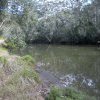
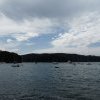
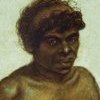
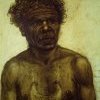
 drawn by Mikhailov, 1820, courtesy AIATSIS.thumbnail.jpg)
